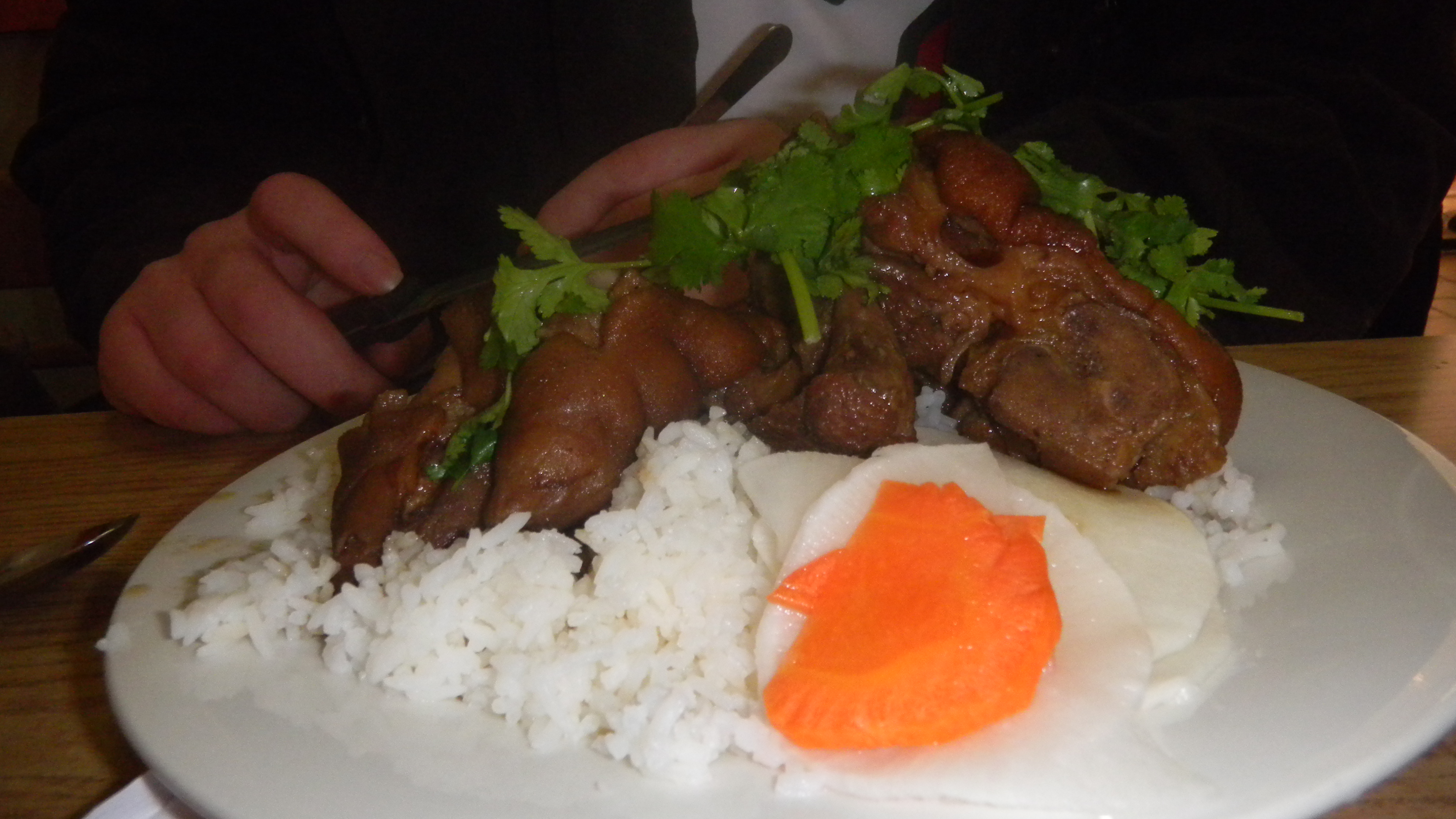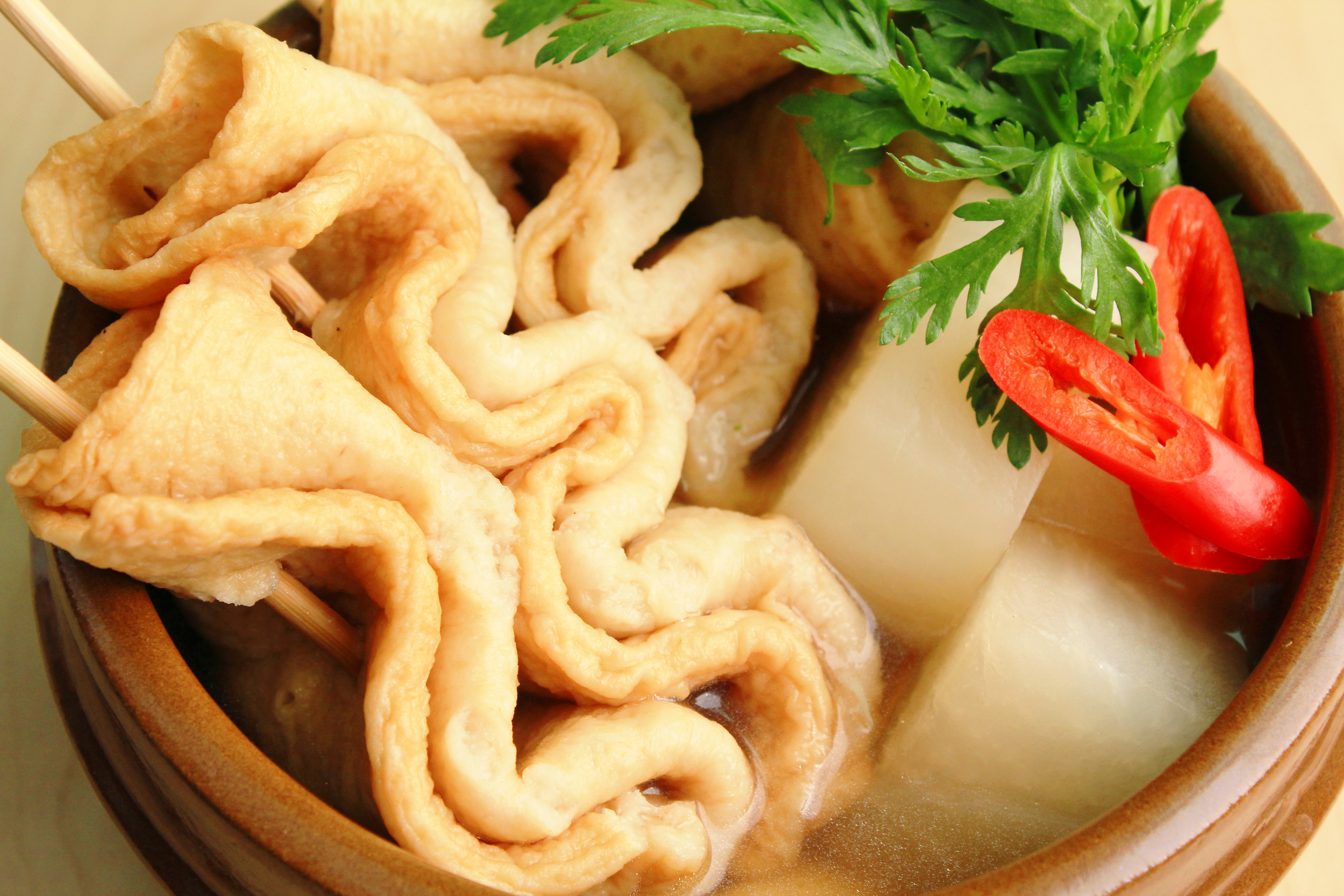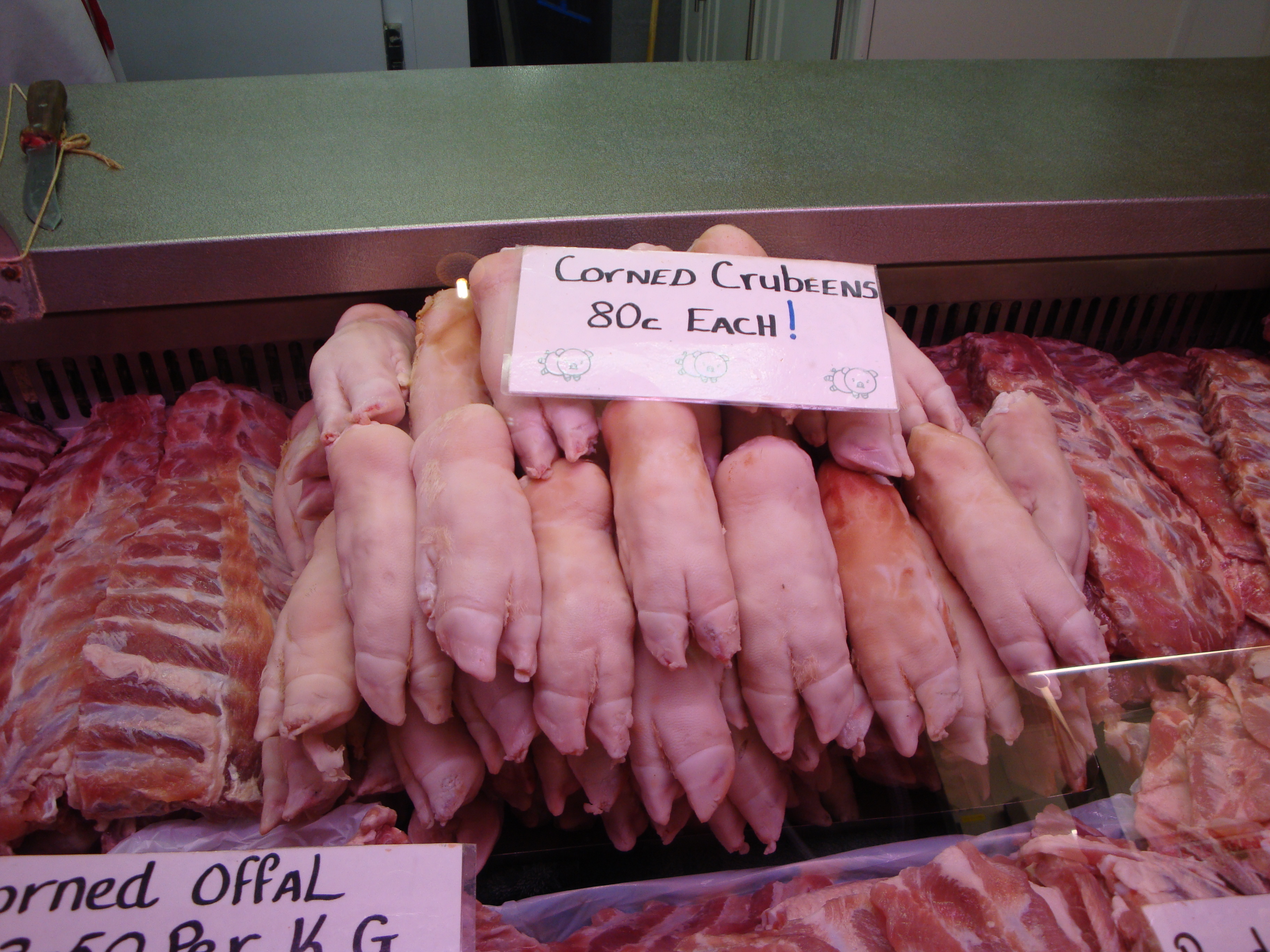|
Pig's Trotters
A pig's trotter, also known as a pettitoe, is the culinary term for a pig's foot. It is used as a cut of pork in various dishes around the world, and experienced a resurgence in the late 2000s. Description image:Crubeens 2008.jpg, Pigs' trotters, sold as Irish-style crubeens in Illinois image:Wonton Noodles with Pig Trotters Braised With Fermented Beancurd.jpg, Wonton noodles with pigs' trotters braised with ''nam yu'' (fermented bean curd) Before sale, the trotters are cleaned and typically have the hairs pulled with a hot tank and beaters. They are often used in cooking to make stocks, as they add thickness to gravy, although they are also served as a normal cut of meat. In Puerto Rico, a tomato-based stew of pigs' trotters with chickpeas is called ''patitas de cerdo''. Sometimes potatoes or butternut are added. British chef Marco Pierre White has long served trotters at his restaurants, based on the original recipe of mentor Pierre Koffmann. Following the Great Recession, ther ... [...More Info...] [...Related Items...] OR: [Wikipedia] [Google] [Baidu] |
Cappello Da Prete
''Cappello del prete'' (sometimes called ''tricorno'') is a variety of Italian ''salume'' typical of Parma and Piacenza. It is recognized as a (PAT). History The ''cappello del prete'' is a product of ancient origin. Its preparation was already widespread in the 16th century tradition of butchery, when in Emilia-Romagna it was prepared to be consumed during the Easter holidays or during Carnival Carnival (known as Shrovetide in certain localities) is a festive season that occurs at the close of the Christian pre-Lenten period, consisting of Quinquagesima or Shrove Sunday, Shrove Monday, and Shrove Tuesday or Mardi Gras. Carnival typi .... Preparation The meat used for the preparation of the ''cappello del prete'' is that of the pork shoulder. This is first deboned, then the muscles of the shoulder are removed from the rind which is carefully preserved to act as an external coating. The meat thus obtained is then salted and spiced with peppercorns and aromatic herbs a ... [...More Info...] [...Related Items...] OR: [Wikipedia] [Google] [Baidu] |
Patatim
''Pata tim'', also spelled ''patatim'', is a Filipino braised pork hock dish slow-cooked until very tender in soy sauce, black peppercorns, garlic, bay leaves, and star anise sweetened with ''muscovado'' sugar. It also commonly includes '' péchay'' and mushrooms. The dish is commonly served in regions in the Philippines with large Chinese Filipino populations, especially in the Binondo district of Manila. Origin ''Pata tim'', like the more common '' humbà'', is derived from the Chinese red braised pork. It is closer to the original dish than ''humbà'', in that it sometimes uses Chinese rice wine and other Chinese spices and condiments. However, it is more commonly cooked closer to the Filipino '' paksiw na pata'', but it does not use vinegar or uses only a very small amount of it. Like ''humbà'', it can also add common Filipino ingredients like pineapples, banana flowers, saba bananas, and '' patis''. The name, ''pata tim'', as part of the Filipino language is origin ... [...More Info...] [...Related Items...] OR: [Wikipedia] [Google] [Baidu] |
Paksiw
''Paksiw'' () is a Filipino style of cooking, whose name means "to cook and simmer in vinegar". Common dishes bearing the term, however, can vary substantially depending on what is being cooked. '' Pinangat na isda'' may sometimes also be referred to as ''paksiw'', though it is a different but related dish that uses sour fruits like calamansi, ''kamias'' (bilimbi) or ''sampalok'' (tamarind) to sour the broth rather than vinegar. Types ''Paksiw'' refers to a wide range of very different dishes that are cooked in a vinegar broth. They include the following: Ginataang paksiw na isda A common variant of ''ginataang isda'' (fish in coconut milk) that adds vinegar to sour the broth. This variant combines the '' ginataan'' and ''paksiw'' methods of cooking in Filipino cuisine. Inun-unan ''Inun-unan'' or ''inun-onan'' is a notable Visayan version of the fish ''paksiw'' dish spiced primarily with ginger, as well as onions, shallots, pepper, salt, and sometimes siling haba c ... [...More Info...] [...Related Items...] OR: [Wikipedia] [Google] [Baidu] |
Crispy Pata
Crispy pata is a Filipino dish consisting of deep fried pig trotters or knuckles served with a soy-vinegar dip. It can be served as party fare or an everyday dish. Many restaurants serve ''boneless pata'' as a specialty. The dish is quite similar to the German Schweinshaxe. See also * * Bagnet * List of deep fried foods * List of Philippine dishes * List of pork dishes * Pata tim * Philippine cuisine Filipino cuisine is composed of the cuisines of more than a hundred distinct Ethnic groups in the Philippines, ethnolinguistic groups found throughout the Philippines, Philippine archipelago. A majority of mainstream Filipino dishes that comp ... Traditional Filipino Recipes References Deep fried foods Philippine pork dishes {{philippines-cuisine-stub ... [...More Info...] [...Related Items...] OR: [Wikipedia] [Google] [Baidu] |
Laos
Laos, officially the Lao People's Democratic Republic (LPDR), is the only landlocked country in Southeast Asia. It is bordered by Myanmar and China to the northwest, Vietnam to the east, Cambodia to the southeast, and Thailand to the west and southwest. The country has a population of approximately eight million. Its Capital city, capital and most populous city is Vientiane. The country is characterized by mountainous terrain, Buddhist temples, including the UNESCO's World Heritage Site of Luang Prabang, and French colonial architecture. The country traces its historic and cultural identity to Lan Xang, a kingdom which existed from the 13th to 18th centuries. Through its location, the kingdom was a hub for overland trade. In 1707, Lan Xang split into three kingdoms: Kingdom of Luang Phrabang, Luang Prabang, Kingdom of Vientiane, Vientiane, and Kingdom of Champasak, Champasak. In 1893, these kingdoms were unified under French protection as part of French Indochina. Laos was und ... [...More Info...] [...Related Items...] OR: [Wikipedia] [Google] [Baidu] |
Tom Tin Moo
Lao cuisine or Laotian cuisine (, , ) is the national cuisine of Laos. The staple food of the Lao is sticky rice (, ''khao niao'', ). Laos has the highest sticky rice consumption per capita in the world with an average of of sticky rice consumed annually per person. Sticky rice is deeply ingrained in the culture, religious tradition, and national identity of Laos. It is a common belief within the Lao community that no matter where they are in the world, sticky rice will always be the glue that holds the Lao communities together, connecting them to their culture and to Laos. Affinity for sticky rice is considered the essence of what it means to be Lao. Often the Lao will refer to themselves as ''luk khao niao'' (, ), which can be translated as 'children or descendants of sticky rice'. The International Rice Research Institute (IRRI) has described Laos as a "collector's paradise". Laos has the highest degrees of biodiversity of sticky rice in the world. As of 2013, approxim ... [...More Info...] [...Related Items...] OR: [Wikipedia] [Google] [Baidu] |
Okinawa Prefecture
is the southernmost and westernmost prefecture of Japan. It consists of three main island groups—the Okinawa Islands, the Sakishima Islands, and the Daitō Islands—spread across a maritime zone approximately 1,000 kilometers east to west and 400 kilometers north to south. Despite a modest land area of 2,281 km² (880 sq mi), Okinawa’s territorial extent over surrounding seas makes its total area nearly half the combined size of Honshu, Shikoku, and Kyushu. Of its 160 Island, islands, 49 are inhabited. The largest and most populous island is Okinawa Island, which hosts the capital city, Naha, as well as major urban centers such as Okinawa (city), Okinawa, Uruma, and Urasoe, Okinawa, Urasoe. The prefecture has a subtropical climate, characterized by warm temperatures and high rainfall throughout the year. People from the Ryukyu Islands, Nansei Islands, including Okinawa Island, Okinawa, the Sakishima Islands, and parts of Kagoshima Prefecture, are often collectively referred ... [...More Info...] [...Related Items...] OR: [Wikipedia] [Google] [Baidu] |
Tebichi
is a type of nabemono (Japanese one-pot dishes) consisting of several ingredients such as boiled eggs, daikon or konjac, and processed fishcakes stewed in a light, soy-flavored dashi broth. Oden was originally what is now commonly called ' or simply ''dengaku''; konjac (''konnyaku'') or tofu was boiled and eaten with miso. Later, instead of using miso, ingredients were cooked in dashi, and oden became popular. Ingredients vary according to region and between each household. Karashi is often used as a condiment. Oden is often sold from food carts, though some izakayas and several convenience store chains also serve it, and dedicated oden restaurants exist. Many different varieties are sold, with single-ingredient dishes sometimes as cheap as 100 yen. While it is usually considered a winter food, some carts and restaurants offer oden year-round. Many of these restaurants keep their broth as a master stock, replenishing it as it simmers to let the flavor deepen and de ... [...More Info...] [...Related Items...] OR: [Wikipedia] [Google] [Baidu] |
Sainte-Menehould
Sainte-Menehould (; ) is a Communes of France, commune in the Marne (department), Marne Departments of France, department in north-eastern France. The 18th-century French playwright Charles-Georges Fenouillot de Falbaire de Quingey (1727–1800) died in Sainte-Ménéhould. It was the Subprefectures in France, subprefecture of the arrondissement of Sainte-Menehould until its abolition in April 2017.Décret n° 2017-453 du 29 mars 2017 portant suppression de l'arrondissement de Sainte-Menehould (département de la Marne) History Dom Pérignon (monk), Dom Pérignon, the Order of St. Benedict, Benedictine monk who made important contributions to the production and quality of Champag ...[...More Info...] [...Related Items...] OR: [Wikipedia] [Google] [Baidu] |
Crubeens
Crubeens (from Irish ''crúibín'', meaning "pig's trotter") are an Irish dish made of boiled pigs' feet. They are traditionally eaten by hand, like corn on the cob. Crubeens can include the pigs' calves, and can be consumed fried, broiled, baked, or otherwise prepared. The Irish singer Liam Clancy references them in a preamble to the song The Galway Races, and they are mentioned in the lyrics of some versions as an example of food available at a horse race. See also * List of Irish dishes References External links Cruibini (Grilled Pigs' Trotters) recipe Irish cuisine Pig's trotters Irish meat dishes {{meat-stub ... [...More Info...] [...Related Items...] OR: [Wikipedia] [Google] [Baidu] |
Körömpörkölt
A pig's trotter, also known as a pettitoe, is the culinary term for a pig's foot. It is used as a cut of pork in various dishes around the world, and experienced a resurgence in the late 2000s. Description Pigs' trotters, sold as Irish-style crubeens in Illinois Wonton noodles with pigs' trotters braised with ''nam yu'' (fermented bean curd) Before sale, the trotters are cleaned and typically have the hairs pulled with a hot tank and beaters. They are often used in cooking to make stocks, as they add thickness to gravy, although they are also served as a normal cut of meat. In Puerto Rico, a tomato-based stew of pigs' trotters with chickpeas is called ''patitas de cerdo''. Sometimes potatoes or butternut are added. British chef Marco Pierre White has long served trotters at his restaurants, based on the original recipe of mentor Pierre Koffmann. Following the Great Recession, there was a boom in popularity of pigs' trotters in the United Kingdom as a revival in cheap meat reci ... [...More Info...] [...Related Items...] OR: [Wikipedia] [Google] [Baidu] |






